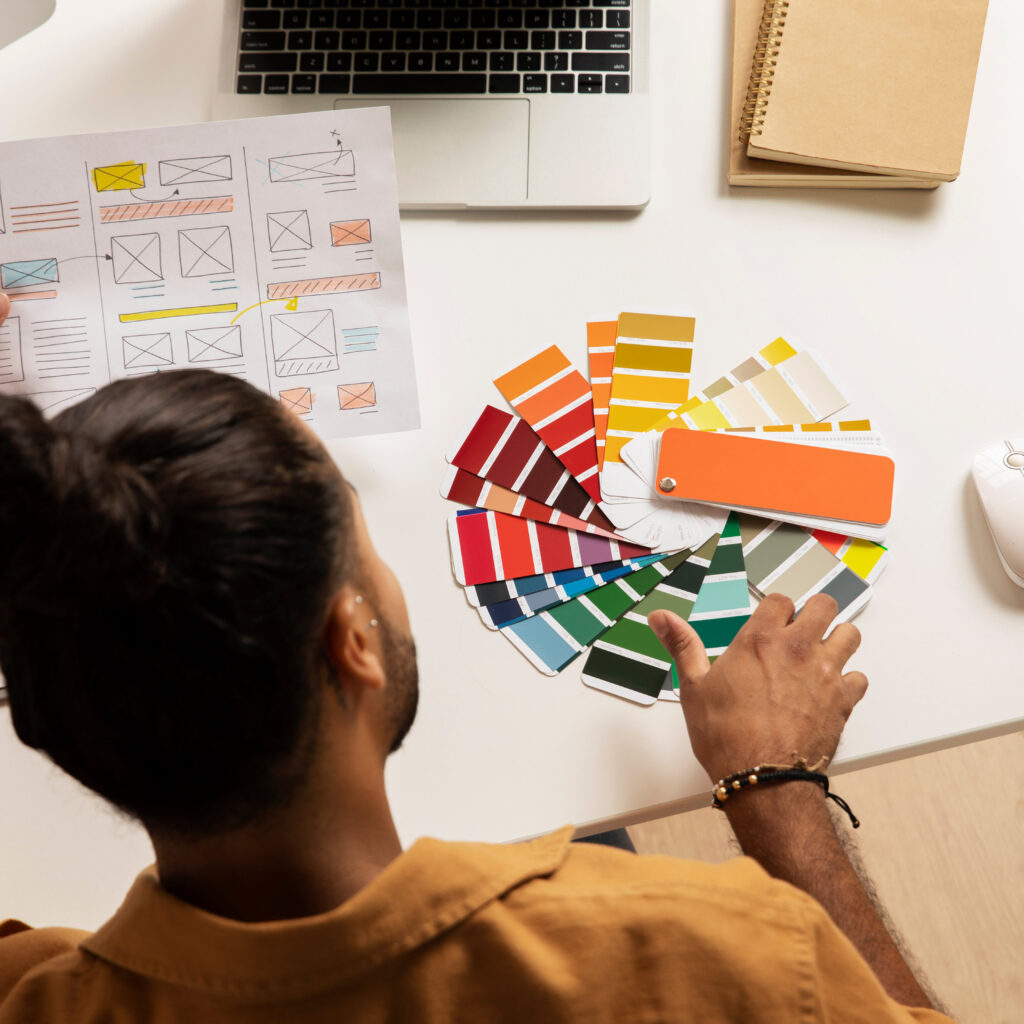Ever wonder why some designs instantly grab your attention, artworks feel emotionally charged, or brands become unforgettable? The secret often lies in colour theory—the invisible force that shapes how we see, feel, and connect with visuals.
If you are designing a logo, painting a masterpiece, or launching a marketing campaign, understanding colour is your superpower.
This guide isn’t just about colour theory—it’s your roadmap to how to learn color theory online? Step by step, we’ll break down complex ideas into bite-sized lessons, share free tools, and point you to the best digital resources.
Step 1: Master the Color Wheel with Online Tools
Before tackling complex palettes, start with the colour wheel—your cheat sheet for all things colour. Learning this foundation is the first step in discovering how to learn colour theory online effectively.

Primary, Secondary, and Tertiary Colors: The Basics
- Primary colours (red, yellow, blue) are the roots—they can’t be created by mixing other hues.
- Secondary colours (green, orange, purple) form when two primaries blend.
- Tertiary colours (like red-orange or blue-green) add depth by mixing a primary with a secondary.
Interactive Tools for Instant Clarity
Struggling to visualise color relationships? Platforms like Adobe Color and Canva Color Wheel turn abstract theory into clickable, interactive lessons—no art degree required. Spin digital wheels, drag sliders, and watch colors harmonize in real time.
This hands-on approach is how to learn color theory online effectively: experiment risk-free, see instant feedback, and grasp concepts like a pro.
Learn from Free Tutorials (how to learn color theory online?)
YouTube channels like GCFLearnFree offer quick, digestible lessons. Their “Colour Wheel Basics” video explains these concepts in under 10 minutes—perfect for a coffee break.
Get Hands-On with Digital Tools
Open Procreate or Figma and start mixing! Try recreating the colour wheel digitally, or experiment with blending modes. Notice how adjusting ratios changes a colour’s warmth or intensity? That’s the magic of practice.
Why This Works
Pairing free online tools with bite-sized lessons, you’re not just memorizing—you’re doing. And that’s the secret to how to learn color theory online: turn theory into action, one click (or swipe) at a time.
Step 2: Explore Color Harmonies Digitally
Once you’ve nailed the color wheel, it’s time to dive into color harmonies—the art of combining hues in ways that feel balanced and visually pleasing. This step is key to how to learn color theory online like a pro.

Complementary, Analogous, and Triadic Schemes
- Complementary colors (opposites on the wheel, like blue and orange) create bold contrast.
- Analogous colors (neighbors, like green, teal, and blue) offer smooth, cohesive vibes.
- Triadic schemes (three evenly spaced hues, like purple, orange, and green) deliver vibrant energy.
Tools to Simplify the Process
Use Coolors.co to generate palettes with a spacebar tap, or Paletton to test harmonies in real time. These tools remove the guesswork, letting you focus on creativity.
Case Study: Learn from the Best
Browse award-winning sites on Awards or Behance. Notice how top designers use harmonies: a tech site might use analogous blues for trust, while a festival site pops with triadic energy. Reverse-engineer their choices to sharpen your eye.
Activity: Build a Digital Mood Board
Head to Pinterest or Milanote and curate images, logos, and designs that use your favorite schemes. Seeing harmonies “in the wild” helps you internalize patterns and sparks ideas for your projects.
Step 3: Study Color Psychology Through Online Courses
Colors aren’t just pretty—they’re powerful. Want to know why fast-food chains love red, or tech brands lean on blue? Color psychology unlocks how hues shape emotions and decisions—a must-know for anyone mastering how to learn color theory online.

Why Colors Matter
- Red: Triggers urgency (think clearance sales) or appetite (McDonald’s).
- Blue: Builds trust (used by Facebook and LinkedIn).
- Yellow: Radiates optimism (Snapchat’s playful vibe).
Learn from Experts
Enroll in Coursera’s Graphic Design Specialization (UC Davis) for academic depth, or dive into Skillshare’s bite-sized classes on color psychology. These courses blend theory with real-world examples, showing how brands strategically “hack” emotions with color.
Test Your Knowledge
Solidify your learning with Quizlet flashcards or quick online quizzes. Can you guess why hospitals use green? (Hint: It’s calming!)
By pairing courses with practical examples, you’ll learn how to learn color theory online in a way that’s both insightful and actionable.
Step 4: Apply Color Theory to Branding via Virtual Workshops
Great branding isn’t just about a catchy logo—it’s about color telling your story. Learning how to learn color theory online means discovering how to use hues strategically in logos, ads, and brand identities.
Color’s Role in Branding
- Logos: Think Coca-Cola’s bold red (energy, passion) or Spotify’s vibrant green (growth, freshness).
- Marketing: Colors guide attention—Instagram’s gradient evokes creativity, while banking apps use blue for trust.
- Brand Identity: Consistency in color builds recognition (e.g., Tiffany & Co.’s robin’s egg blue).
Learn from Virtual Workshops
Join Adobe Live for live design critiques, or take LinkedIn Learning’s Branding Foundations to see how pros craft palettes that resonate. These workshops break down how color choices align with brand values—like using earthy tones for eco-friendly brands.
Tools to Practice Like a Pro
- Canva Brand Kit: Experiment with palettes and see how colors look on mockups (websites, merch).
- Tailor Brands: Use AI tools to generate logo ideas and test color variations in minutes.
Activity: Redesign a Fictional Brand
Grab BrandPitche’s free templates and reimagine a brand’s identity. Maybe turn a “boring” insurance company into something approachable with soft blues and yellows. Share your work online for feedback—no budget or clients needed!
Step 7: Integrate Knowledge with Online Projects
Learning how to learn color theory online isn’t complete without real-world practice. Now’s the time to collaborate, create, and showcase your skills.
Join Design Communities
- Reddit’s r/design_critiques: Post your color palettes for constructive feedback.
- Discord design servers: Chat with peers, share resources, and join color-themed challenges.
These spaces turn solitary learning into a team sport—ask questions, brainstorm, and grow faster.
Test Skills in Design Challenges
Sign up for Daily UI (daily prompts for apps/logos) or Adobe Creative Jam (timed competitions). For example, redesign a music app using triadic colors—how does it affect user mood? Challenges push you to apply theory under pressure, sharpening your instincts.
Build a Killer Portfolio
Use Behance or a WordPress site to display projects. Group work by color themes: “Bold Branding,” “Minimalist Palettes,” etc. Add notes explaining your choices—like why you picked analogous greens for a wellness brand.
Why This Works
Communities and challenges turn theory into muscle memory. How to learn color theory isn’t about just studying, when you share your works. You will realise it is about doing, failing, improving, and repeating.
Conclusion
You’ve journeyed through the essentials of how to learn color theory online—from mastering the color wheel to crafting brand identities and joining global design communities. Each step isn’t just about memorizing rules; it’s about unlocking creative confidence.
Color trends evolve, tools upgrade, and your creativity will too. Stay curious—refresh your knowledge with new courses, follow design influencers, or revisit tools like Coolors and Adobe Color.
Ready to shine? Share your projects—a logo, website, or mood board—on Instagram, Behance, or LinkedIn.

0 Responses